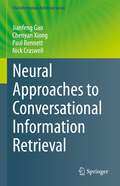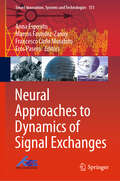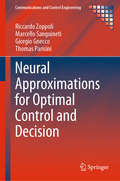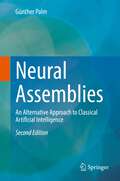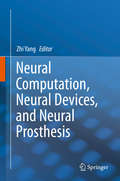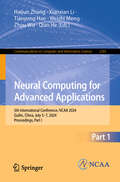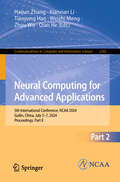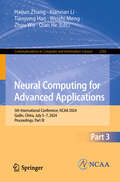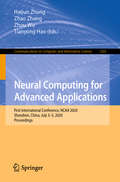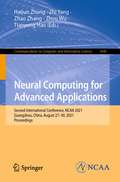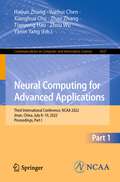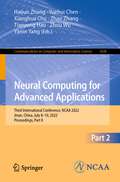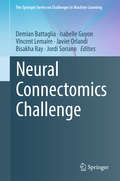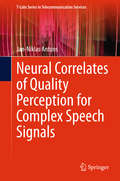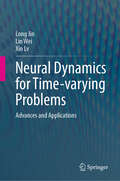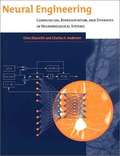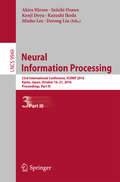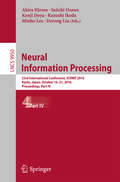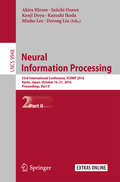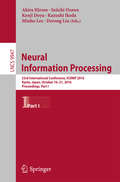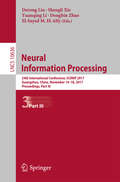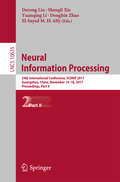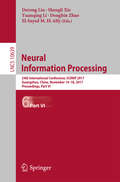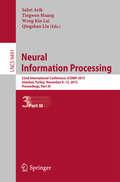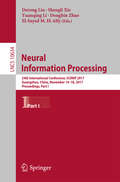- Table View
- List View
Neural Approaches to Conversational Information Retrieval (The Information Retrieval Series #44)
by Paul Bennett Nick Craswell Jianfeng Gao Chenyan XiongThis book surveys recent advances in Conversational Information Retrieval (CIR), focusing on neural approaches that have been developed in the last few years. Progress in deep learning has brought tremendous improvements in natural language processing (NLP) and conversational AI, leading to a plethora of commercial conversational services that allow naturally spoken and typed interaction, increasing the need for more human-centric interactions in IR.The book contains nine chapters. Chapter 1 motivates the research of CIR by reviewing the studies on how people search and subsequently defines a CIR system and a reference architecture which is described in detail in the rest of the book. Chapter 2 provides a detailed discussion of techniques for evaluating a CIR system – a goal-oriented conversational AI system with a human in the loop. Then Chapters 3 to 7 describe the algorithms and methods for developing the main CIR modules (or sub-systems). In Chapter 3, conversational document search is discussed, which can be viewed as a sub-system of the CIR system. Chapter 4 is about algorithms and methods for query-focused multi-document summarization. Chapter 5 describes various neural models for conversational machine comprehension, which generate a direct answer to a user query based on retrieved query-relevant documents, while Chapter 6 details neural approaches to conversational question answering over knowledge bases, which is fundamental to the knowledge base search module of a CIR system. Chapter 7 elaborates various techniques and models that aim to equip a CIR system with the capability of proactively leading a human-machine conversation. Chapter 8 reviews a variety of commercial systems for CIR and related tasks. It first presents an overview of research platforms and toolkits which enable scientists and practitioners to build conversational experiences, and continues with historical highlights and recent trends in a range of application areas. Chapter 9 eventually concludes the book with a brief discussion of research trends and areas for future work. The primary target audience of the book are the IR and NLP research communities. However, audiences with another background, such as machine learning or human-computer interaction, will also find it an accessible introduction to CIR.
Neural Approaches to Dynamics of Signal Exchanges (Smart Innovation, Systems and Technologies #151)
by Anna Esposito Marcos Faundez-Zanuy Francesco Carlo Morabito Eros PaseroThe book presents research that contributes to the development of intelligent dialog systems to simplify diverse aspects of everyday life, such as medical diagnosis and entertainment. Covering major thematic areas: machine learning and artificial neural networks; algorithms and models; and social and biometric data for applications in human–computer interfaces, it discusses processing of audio-visual signals for the detection of user-perceived states, the latest scientific discoveries in processing verbal (lexicon, syntax, and pragmatics), auditory (voice, intonation, vocal expressions) and visual signals (gestures, body language, facial expressions), as well as algorithms for detecting communication disorders, remote health-status monitoring, sentiment and affect analysis, social behaviors and engagement. Further, it examines neural and machine learning algorithms for the implementation of advanced telecommunication systems, communication with people with special needs, emotion modulation by computer contents, advanced sensors for tracking changes in real-life and automatic systems, as well as the development of advanced human–computer interfaces. The book does not focus on solving a particular problem, but instead describes the results of research that has positive effects in different fields and applications.
Neural Approximations for Optimal Control and Decision (Communications and Control Engineering)
by Riccardo Zoppoli Marcello Sanguineti Giorgio Gnecco Thomas ParisiniNeural Approximations for Optimal Control and Decision provides a comprehensive methodology for the approximate solution of functional optimization problems using neural networks and other nonlinear approximators where the use of traditional optimal control tools is prohibited by complicating factors like non-Gaussian noise, strong nonlinearities, large dimension of state and control vectors, etc. Features of the text include: • a general functional optimization framework; • thorough illustration of recent theoretical insights into the approximate solutions of complex functional optimization problems; • comparison of classical and neural-network based methods of approximate solution; • bounds to the errors of approximate solutions; • solution algorithms for optimal control and decision in deterministic or stochastic environments with perfect or imperfect state measurements over a finite or infinite time horizon and with one decision maker or several; • applications of current interest: routing in communications networks, traffic control, water resource management, etc.; and • numerous, numerically detailed examples. The authors’ diverse backgrounds in systems and control theory, approximation theory, machine learning, and operations research lend the book a range of expertise and subject matter appealing to academics and graduate students in any of those disciplines together with computer science and other areas of engineering.
Neural Assemblies: An Alternative Approach to Classical Artificial Intelligence
by Günther PalmIn the new edition of Neural Assemblies, the author places his original ideas and motivations within the framework of modern and cognitive neuroscience and gives a short and focused overview of the development of computational neuroscience and artificial neural networks over the last 40 years. In this book the author develops a theory of how the human brain might function. Starting with a motivational introduction to the brain as an organ of information processing, he presents a computational perspective on the basic concepts and ideas of neuroscience research on the underlying principles of brain function. In addition, the reader is introduced to the most important methods from computer science and mathematical modeling that are required for a computational understanding of information processing in the brain. Written by an expert in the field of neural information processing, this book offers a personal historical view of the development of artificial intelligence, artificial neural networks, and computational cognitive neuroscience over the last 40 years, with a focus on the realization of higher cognitive functions rather than more peripheral sensory or motor organization. The book is therefore aimed at students and researchers who want to understand how the basic neuroscientific and computational concepts in the study of brain function have changed over the last decades.
Neural Computation, Neural Devices, and Neural Prosthesis
by Zhi YangIn the past decades, interdisciplinary investigations overlapping biology, medicine, information science, and engineering have formed a very exciting and active field that attracts scientists, medical doctors, and engineers with knowledge in different domains. A few examples of such investigations include neural prosthetic implants that aim to improve the quality of life for patients suffering from neurologic disease and injury; brain machine interfaces that sense, analyze, and translate electrical signals from the brain to build closed-loop, biofeedback systems; and fundamental studies of intelligence, cognitive functions, and psychological behaviors correlated to their neurological basis. Although this interdisciplinary area is still in its infancy, it can potentially create some of the most significant impact: treating diseases that are considered untreatable, interpretation and communication of neuron ensembles, or even a revolutionary perception and understanding of life different from philosophical or immaterial approaches. Fortunately, several academic societies recognize the value and impact of this growing field, firmly supporting related research. Such support will drive a booming future in the next twenty or thirty years. Research in this area is frequently project-driven, and the generated knowledge has been scattered in different fields of neuroscience, computation, material and technology, circuits and system, clinical reports, and psychology--the scope considerably across the boundary of traditionally defined disciplines. Neural Computation, Neural Devices, and Neural Prosthesis is intended to assemble such knowledge, from there suggesting a systematic approach guiding future educational and research activities. The targeted audience includes both students and researchers.
Neural Computing for Advanced Applications: 5th International Conference, NCAA 2024, Guilin, China, July 5–7, 2024, Proceedings, Part I (Communications in Computer and Information Science #2181)
by Haijun Zhang Xianxian Li Tianyong Hao Weizhi Meng Zhou Wu Qian HeThis book constitutes the refereed proceedings of the 5th International Conference on Neural Computing for Advanced Applications, NCAA 2024, held in Guilin, China, during July 5–7, 2024. The 89 revised full papers presented in these proceedings were carefully reviewed and selected from 227 submissions. The papers are organized in the following topical sections: Part I: Neural network (NN) theory, NN-based control systems, neuro-system integration and engineering applications; Computer vision, and their engineering applications. Part II: Computational intelligence, nature-inspired optimizers, their engineering applications, and benchmarks. Part III: Natural language processing, knowledge graphs, recommender systems, multimodal Deep Learning, and their applications; Fault diagnosis and forecasting, prognostic management, Time-series analysis, and cyber-physical system security.
Neural Computing for Advanced Applications: 5th International Conference, NCAA 2024, Guilin, China, July 5–7, 2024, Proceedings, Part II (Communications in Computer and Information Science #2182)
by Haijun Zhang Xianxian Li Tianyong Hao Weizhi Meng Zhou Wu Qian HeThis book constitutes the refereed proceedings of the 5th International Conference on Neural Computing for Advanced Applications, NCAA 2024, held in Guilin, China, during July 5–7, 2024. The 89 revised full papers presented in these proceedings were carefully reviewed and selected from 227 submissions. The papers are organized in the following topical sections: Part I: Neural network (NN) theory, NN-based control systems, neuro-system integration and engineering applications; Computer vision, and their engineering applications. Part II: Computational intelligence, nature-inspired optimizers, their engineering applications, and benchmarks. Part III: Natural language processing, knowledge graphs, recommender systems, multimodal Deep Learning, and their applications; Fault diagnosis and forecasting, prognostic management, Time-series analysis, and cyber-physical system security.
Neural Computing for Advanced Applications: 5th International Conference, NCAA 2024, Guilin, China, July 5–7, 2024, Proceedings, Part III (Communications in Computer and Information Science #2183)
by Haijun Zhang Xianxian Li Tianyong Hao Weizhi Meng Zhou Wu Qian HeThis book constitutes the refereed proceedings of the 5th International Conference on Neural Computing for Advanced Applications, NCAA 2024, held in Guilin, China, during July 5–7, 2024. The 89 revised full papers presented in these proceedings were carefully reviewed and selected from 227 submissions. The papers are organized in the following topical sections: Part I: Neural network (NN) theory, NN-based control systems, neuro-system integration and engineering applications; Computer vision, and their engineering applications. Part II: Computational intelligence, nature-inspired optimizers, their engineering applications, and benchmarks. Part III: Natural language processing, knowledge graphs, recommender systems, multimodal Deep Learning, and their applications; Fault diagnosis and forecasting, prognostic management, Time-series analysis, and cyber-physical system security.
Neural Computing for Advanced Applications: First International Conference, NCAA 2020, Shenzhen, China, July 3–5, 2020, Proceedings (Communications in Computer and Information Science #1265)
by Haijun Zhang Zhao Zhang Tianyong Hao Zhou WuThis book presents refereed proceedings of the First International Conference Neural Computing for Advanced Applications, NCAA 2020, held in July, 2020. Due to the COVID-19 pandemic the conference was held online. The 36 full papers and 7 short papers were thorougly reviewed and selected from a total of 113 qualified submissions. Thes papers present resent research on such topics as neural network theory, and cognitive sciences, machine learning, data mining, data security & privacy protection, and data-driven applications, computational intelligence, nature-inspired optimizers, and their engineering applications, cloud/edge/fog computing, the Internet of Things/Vehicles (IoT/IoV), and their system optimization, control systems, network synchronization, system integration, and industrial artificial intelligence, fuzzy logic, neuro-fuzzy systems, decision making, and their applications in management sciences, computer vision, image processing, and their industrial applications, and natural language processing, machine translation, knowledge graphs, and their applications.
Neural Computing for Advanced Applications: Second International Conference, NCAA 2021, Guangzhou, China, August 27-30, 2021, Proceedings (Communications in Computer and Information Science #1449)
by Haijun Zhang Zhi Yang Zhao Zhang Tianyong Hao Zhou WuThis book presents refereed proceedings of the Second International Conference Neural Computing for Advanced Applications, NCAA 2021, held in Guangzhou, China, in August, 2021. The 54 full papers papers were thorougly reviewed and selected from a total of 144 qualified submissions. The papers are organized in topical sections on neural network theory, cognitive sciences, neuro-system hardware implementations, and NN-based engineering applications; machine learning, data mining, data security and privacy protection, and data-driven applications; neural computing-based fault diagnosis, fault forecasting, prognostic management, and system modeling; computational intelligence, nature-inspired optimizers, and their engineering applications; fuzzy logic, neuro-fuzzy systems, decision making, and their applications in management sciences; control systems, network synchronization, system integration, and industrial artificial intelligence; computer vision, image processing, and their industrial applications; cloud/edge/fog computing, the Internet of Things/Vehicles(IoT/IoV), and their system optimization; spreading dynamics, forecasting, and other intelligent techniques against coronavirus disease (COVID-19).
Neural Computing for Advanced Applications: Third International Conference, NCAA 2022, Jinan, China, July 8–10, 2022, Proceedings, Part I (Communications in Computer and Information Science #1637)
by Haijun Zhang Zhao Zhang Tianyong Hao Zhou Wu Yuehui Chen Xianghua Chu Yimin YangThe two-volume Proceedings set CCIS 1637 and 1638 constitutes the refereed proceedings of the Third International Conference on Neural Computing for Advanced Applications, NCAA 2022, held in Jinan, China, during July 8–10, 2022. The 77 papers included in these proceedings were carefully reviewed and selected from 205 submissions. These papers were categorized into 10 technical tracks, i.e., neural network theory, and cognitive sciences, machine learning, data mining, data security & privacy protection, and data-driven applications, computational intelligence, nature-inspired optimizers, and their engineering applications, cloud/edge/fog computing, the Internet of Things/Vehicles (IoT/IoV), and their system optimization, control systems, network synchronization, system integration, and industrial artificial intelligence, fuzzy logic, neuro-fuzzy systems, decision making, and their applications in management sciences, computer vision, image processing, and their industrial applications, natural language processing, machine translation, knowledge graphs, and their applications, Neural computing-based fault diagnosis, fault forecasting, prognostic management, and system modeling, and Spreading dynamics, forecasting, and other intelligent techniques against coronavirus disease (COVID-19).
Neural Computing for Advanced Applications: Third International Conference, NCAA 2022, Jinan, China, July 8–10, 2022, Proceedings, Part II (Communications in Computer and Information Science #1638)
by Haijun Zhang Zhao Zhang Tianyong Hao Zhou Wu Yuehui Chen Xianghua Chu Yimin YangThe two-volume Proceedings set CCIS 1637 and 1638 constitutes the refereed proceedings of the Third International Conference on Neural Computing for Advanced Applications, NCAA 2022, held in Jinan, China, during July 8–10, 2022. The 77 papers included in these proceedings were carefully reviewed and selected from 205 submissions. These papers were categorized into 10 technical tracks, i.e., neural network theory, and cognitive sciences, machine learning, data mining, data security & privacy protection, and data-driven applications, computational intelligence, nature-inspired optimizers, and their engineering applications, cloud/edge/fog computing, the Internet of Things/Vehicles (IoT/IoV), and their system optimization, control systems, network synchronization, system integration, and industrial artificial intelligence, fuzzy logic, neuro-fuzzy systems, decision making, and their applications in management sciences, computer vision, image processing, and their industrial applications, natural language processing, machine translation, knowledge graphs, and their applications, Neural computing-based fault diagnosis, fault forecasting, prognostic management, and system modeling, and Spreading dynamics, forecasting, and other intelligent techniques against coronavirus disease (COVID-19).
Neural Connectomics Challenge
by Demian Battaglia Isabelle Guyon Vincent Lemaire Javier Orlandi Bisakha Ray Jordi SorianoThis book illustrates the thrust of the scientific community to use machine learning concepts for tackling a complex problem: given time series of neuronal spontaneous activity, which is the underlying connectivity between the neurons in the network? The contributing authors also develop tools for the advancement of neuroscience through machine learning techniques, with a focus on the major open problems in neuroscience. While the techniques have been developed for a specific application, they address the more general problem of network reconstruction from observational time series, a problem of interest in a wide variety of domains, including econometrics, epidemiology, and climatology, to cite only a few. The book is designed for the mathematics, physics and computer science communities that carry out research in neuroscience problems. The content is also suitable for the machine learning community because it exemplifies how to approach the same problem from different perspectives.
Neural Correlates of Quality Perception for Complex Speech Signals
by Jan-Niklas AntonsThis book interconnects two essential disciplines to study the perception of speech: Neuroscience and Quality of Experience, which to date have rarely been used together for the purposes of research on speech quality perception. In five key experiments, the book demonstrates the application of standard clinical methods in neurophysiology on the one hand and of methods used in fields of research concerned with speech quality perception on the other. Using this combination, the book shows that speech stimuli with different lengths and different quality impairments are accompanied by physiological reactions related to quality variations, e. g. , a positive peak in an event-related potential. Furthermore, it demonstrates that - in most cases - quality impairment intensity has an impact on the intensity of physiological reactions.
Neural Dynamics for Time-varying Problems: Advances and Applications
by Long Jin Lin Wei Xin LvThis book mainly presents methods based on neural dynamics for the time-varying problems with applications, together with the corresponding theoretical analysis, simulative examples, and physical experiments. Based on these methods, their applications include motion planning of redundant manipulators, filter design, winner-take-all operation, multiple-input multiple-output system configuration, multi-linear tensor equation solving, and manipulability optimization are also presented. In this book, we present the design, proposal, development, analysis, modeling, and simulation of various neural dynamic models, along with their respective applications including motion planning of redundant manipulators, filter design, winner-take-all operation, multiple-input multiple-output system configuration, multi-linear tensor equation solving, and manipulability optimization. Specifically, starting from the top-level considerations of hardware implementation, we integrate computational intelligence methods and control theory to design a series of dynamic and noise-resistant discrete neural dynamic methods. The research work not only owns the theoretical guarantee on its convergence, noise resistance, and accuracy, but demonstrate the effectiveness and robustness in solving various optimization and equation solving problems, particularly in handling time-varying problems and noise perturbations. Moreover, by reducing complexity and avoiding matrix inversion operations, the models’ feasibility and practicality are further enhanced.
Neural Engineering: Computation, Representation, and Dynamics in Neurobiological Systems
by Chris Eliasmith Charles H. AndersonFor years, researchers have used the theoretical tools of engineering to understand neural systems, but much of this work has been conducted in relative isolation. In Neural Engineering, Chris Eliasmith and Charles Anderson provide a synthesis of the disparate approaches current in computational neuroscience, incorporating ideas from neural coding, neural computation, physiology, communications theory, control theory, dynamics, and probability theory. This synthesis, they argue, enables novel theoretical and practical insights into the functioning of neural systems. Such insights are pertinent to experimental and computational neuroscientists and to engineers, physicists, and computer scientists interested in how their quantitative tools relate to the brain. The authors present three principles of neural engineering based on the representation of signals by neural ensembles, transformations of these representations through neuronal coupling weights, and the integration of control theory and neural dynamics. Through detailed examples and in-depth discussion, they make the case that these guiding principles constitute a useful theory for generating large-scale models of neurobiological function. A software package written in MatLab for use with their methodology, as well as examples, course notes, exercises, documentation, and other material, are available on the Web.
Neural Information Processing
by Derong Liu Akira Hirose Seiichi Ozawa Kenji Doya Kazushi Ikeda Minho Leeth This two-volume set constitutes the Proceedings of the 16 International Conference on Neural Information Processing (ICONIP 2009), held in Bangkok, Thailand, during December 1-5, 2009. ICONIP is a world-renowned international conference that is held annually in the Asia-Pacific region. This prestigious event is sponsored by the Asia Pacific Neural Network Assembly (APNNA), and it has provided an annual forum for international researchers to exchange the latest ideas and advances in neural networks and related discipline. The School of Information Technology (SIT) at King Mongkut's University of Technology Thonburi (KMUTT), Bangkok, Thailand was the proud host of ICONIP 2009. The conference theme was "Challenges and Trends of Neural Information Processing," with an aim to discuss the past, present, and future challenges and trends in the field of neural information processing. ICONIP 2009 accepted 145 regular session papers and 53 special session papers from a total of 466 submissions received on the Springer Online Conference Service (OCS) system. The authors of accepted papers alone covered 36 countries and - gions worldwide and there are over 500 authors in these proceedings. The technical sessions were divided into 23 topical categories, including 9 special sessions.
Neural Information Processing
by Derong Liu Akira Hirose Seiichi Ozawa Kenji Doya Kazushi Ikeda Minho Leeth This two-volume set constitutes the Proceedings of the 16 International Conference on Neural Information Processing (ICONIP 2009), held in Bangkok, Thailand, during December 1-5, 2009. ICONIP is a world-renowned international conference that is held annually in the Asia-Pacific region. This prestigious event is sponsored by the Asia Pacific Neural Network Assembly (APNNA), and it has provided an annual forum for international researchers to exchange the latest ideas and advances in neural networks and related discipline. The School of Information Technology (SIT) at King Mongkut's University of Technology Thonburi (KMUTT), Bangkok, Thailand was the proud host of ICONIP 2009. The conference theme was "Challenges and Trends of Neural Information Processing," with an aim to discuss the past, present, and future challenges and trends in the field of neural information processing. ICONIP 2009 accepted 145 regular session papers and 53 special session papers from a total of 466 submissions received on the Springer Online Conference Service (OCS) system. The authors of accepted papers alone covered 36 countries and - gions worldwide and there are over 500 authors in these proceedings. The technical sessions were divided into 23 topical categories, including 9 special sessions.
Neural Information Processing
by Derong Liu Akira Hirose Seiichi Ozawa Kenji Doya Kazushi Ikeda Minho Leeth This two-volume set constitutes the Proceedings of the 16 International Conference on Neural Information Processing (ICONIP 2009), held in Bangkok, Thailand, during December 1-5, 2009. ICONIP is a world-renowned international conference that is held annually in the Asia-Pacific region. This prestigious event is sponsored by the Asia Pacific Neural Network Assembly (APNNA), and it has provided an annual forum for international researchers to exchange the latest ideas and advances in neural networks and related discipline. The School of Information Technology (SIT) at King Mongkut's University of Technology Thonburi (KMUTT), Bangkok, Thailand was the proud host of ICONIP 2009. The conference theme was "Challenges and Trends of Neural Information Processing," with an aim to discuss the past, present, and future challenges and trends in the field of neural information processing. ICONIP 2009 accepted 145 regular session papers and 53 special session papers from a total of 466 submissions received on the Springer Online Conference Service (OCS) system. The authors of accepted papers alone covered 36 countries and - gions worldwide and there are over 500 authors in these proceedings. The technical sessions were divided into 23 topical categories, including 9 special sessions.
Neural Information Processing
by Derong Liu Akira Hirose Seiichi Ozawa Kenji Doya Kazushi Ikeda Minho Leeth This two-volume set constitutes the Proceedings of the 16 International Conference on Neural Information Processing (ICONIP 2009), held in Bangkok, Thailand, during December 1-5, 2009. ICONIP is a world-renowned international conference that is held annually in the Asia-Pacific region. This prestigious event is sponsored by the Asia Pacific Neural Network Assembly (APNNA), and it has provided an annual forum for international researchers to exchange the latest ideas and advances in neural networks and related discipline. The School of Information Technology (SIT) at King Mongkut's University of Technology Thonburi (KMUTT), Bangkok, Thailand was the proud host of ICONIP 2009. The conference theme was "Challenges and Trends of Neural Information Processing," with an aim to discuss the past, present, and future challenges and trends in the field of neural information processing. ICONIP 2009 accepted 145 regular session papers and 53 special session papers from a total of 466 submissions received on the Springer Online Conference Service (OCS) system. The authors of accepted papers alone covered 36 countries and - gions worldwide and there are over 500 authors in these proceedings. The technical sessions were divided into 23 topical categories, including 9 special sessions.
Neural Information Processing
by Derong Liu Shengli Xie Yuanqing Li Dongbin Zhao El-Sayed M. El-AlfyThe four volume set LNCS 9947, LNCS 9948, LNCS 9949, and LNCS 9950 constitutes the proceedings of the 23rd International Conference on Neural Information Processing, ICONIP 2016, held in Kyoto, Japan, in October 2016. The 296 full papers presented were carefully reviewed and selected from 431 submissions. The 4 volumes are organized in topical sections on deep and reinforcement learning; big data analysis; neural data analysis; robotics and control; bio-inspired/energy efficient information processing; whole brain architecture; neurodynamics; bioinformatics; biomedical engineering; data mining and cybersecurity workshop; machine learning; neuromorphic hardware; sensory perception; pattern recognition; social networks; brain-machine interface; computer vision; time series analysis; data-driven approach for extracting latent features; topological and graph based clustering methods; computational intelligence; data mining; deep neural networks; computational and cognitive neurosciences; theory and algorithms.
Neural Information Processing
by Derong Liu Shengli Xie Yuanqing Li Dongbin Zhao El-Sayed M. El-AlfyThe four volume set LNCS 9947, LNCS 9948, LNCS 9949, and LNCS 9950 constitutes the proceedings of the 23rd International Conference on Neural Information Processing, ICONIP 2016, held in Kyoto, Japan, in October 2016. The 296 full papers presented were carefully reviewed and selected from 431 submissions. The 4 volumes are organized in topical sections on deep and reinforcement learning; big data analysis; neural data analysis; robotics and control; bio-inspired/energy efficient information processing; whole brain architecture; neurodynamics; bioinformatics; biomedical engineering; data mining and cybersecurity workshop; machine learning; neuromorphic hardware; sensory perception; pattern recognition; social networks; brain-machine interface; computer vision; time series analysis; data-driven approach for extracting latent features; topological and graph based clustering methods; computational intelligence; data mining; deep neural networks; computational and cognitive neurosciences; theory and algorithms.
Neural Information Processing
by Derong Liu Shengli Xie Yuanqing Li Dongbin Zhao El-Sayed M. El-AlfyThe four volume set LNCS 9947, LNCS 9948, LNCS 9949, and LNCS 9950 constitutes the proceedings of the 23rd International Conference on Neural Information Processing, ICONIP 2016, held in Kyoto, Japan, in October 2016. The 296 full papers presented were carefully reviewed and selected from 431 submissions. The 4 volumes are organized in topical sections on deep and reinforcement learning; big data analysis; neural data analysis; robotics and control; bio-inspired/energy efficient information processing; whole brain architecture; neurodynamics; bioinformatics; biomedical engineering; data mining and cybersecurity workshop; machine learning; neuromorphic hardware; sensory perception; pattern recognition; social networks; brain-machine interface; computer vision; time series analysis; data-driven approach for extracting latent features; topological and graph based clustering methods; computational intelligence; data mining; deep neural networks; computational and cognitive neurosciences; theory and algorithms.
Neural Information Processing
by Sabri Arik Tingwen Huang Weng Kin Lai Qingshan LiuThe four volume set LNCS 9489, LNCS 9490, LNCS 9491, andLNCS 9492 constitutes the proceedings of the 22nd International Conference onNeural Information Processing, ICONIP 2015, held in Istanbul, Turkey, inNovember 2015. The 231 full papers presented were carefully reviewed andselected from 375 submissions. The 4 volumes represent topical sectionscontaining articles on Learning Algorithms and Classification Systems;Artificial Intelligence and Neural Networks: Theory, Design, and Applications;Image and Signal Processing; and Intelligent Social Networks.
Neural Information Processing: 24th International Conference, ICONIP 2017, Guangzhou, China, November 14-18, 2017, Proceedings, Part I (Lecture Notes in Computer Science #10634)
by Derong Liu, Shengli Xie, Yuanqing Li, Dongbin Zhao and El-Sayed M. El-AlfyThe six volume set LNCS 10634, LNCS 10635, LNCS 10636, LNCS 10637, LNCS 10638, and LNCS 10639 constitues the proceedings of the 24rd International Conference on Neural Information Processing, ICONIP 2017, held in Guangzhou, China, in November 2017. The 563 full papers presented were carefully reviewed and selected from 856 submissions. The 6 volumes are organized in topical sections on Machine Learning, Reinforcement Learning, Big Data Analysis, Deep Learning, Brain-Computer Interface, Computational Finance, Computer Vision, Neurodynamics, Sensory Perception and Decision Making, Computational Intelligence, Neural Data Analysis, Biomedical Engineering, Emotion and Bayesian Networks, Data Mining, Time-Series Analysis, Social Networks, Bioinformatics, Information Security and Social Cognition, Robotics and Control, Pattern Recognition, Neuromorphic Hardware and Speech Processing.
